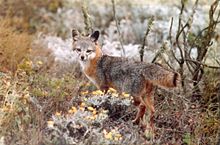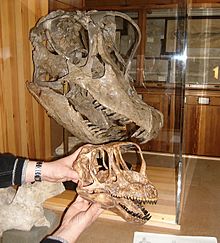Insular dwarfism
Island dwarfing is an evolutionary biological phenomenon in which the body size of animal species living on an island without predators or human interference decreases significantly ("dwarfs") over generations.
The first research work on island dwarfing was done by the Canadian biologist J. Bristol Foster (* 1932). For him, the adaptive mechanisms in overpopulation are the decisive factor as to whether an animal species tends towards dwarfing or island gigantism.
Examples of island warping include:
- Homo floresiensis, an extinct representative of the genus Homo discovered on the island of Flores, and the native anatomically modern humans (Homo sapiens) living on Flores.
- Different extinct dwarf-elephant-types, dwarf-forms of elephants and mammoths on some Mediterranean-islands (Sicilian dwarf-elephant or Crete-dwarf-mammoth), on the channel-islands of California (dwarf-mammoth) respectively in another Varietät on the Wrangelinsel as well as of Stegodonten on different islands of the southeast-Asian archipelago.
- Malagasy hippos and hippos on Mediterranean islands.
- the extinct Honshū-wolf in Japan.
- the island gray fox on the California Channel Islands. It evolved from the gray fox after specimens of that species arrived on the northern three Channel Islands. Today, this species of true fox is much smaller than the ancestral form, with a body size roughly equal to that of a domestic cat.
- the white-tailed deer in the Florida Keys.
- Svalbard reindeer on the island of Spitsbergen are only 65 cm high, while reindeer on the mainland have an average shoulder height of about 110 cm.
- Fossil evidence of the phenomenon was also found in the sauropod dinosaur Europasaurus, described in 2006, which inhabited an island in what is now northern Germany during the Late Jurassic. While closely related forms on the mainland could reach up to 40 meters in length and weigh 50 to 80 tons, Europasaurus was already fully grown at about 6.20 meters in length and one ton in weight.
The tendency to island warping can also be observed in raccoons, rabbits, pigs and deer. With few exceptions, snakes also tend to island dwarfism. Small rodents on islands, on the other hand, tend toward island gigantism, i.e., island forms of the animal order tend to develop significantly larger body forms than on the mainland. The tendency to giantism can also be observed in iguanas, geckos, skinks and monitor lizards such as the Komodo dragon.
On the Dodecanese island of Tilos, the bones of a dwarf elephant species were recovered during excavations in the Charkadio Cave. The youngest 14C date from the fossil-bearing stratum (4390±600 BP uncal) suggests a date between 4340 and 1520 BC. The Tilos pygmy elephant (Elephas tiliensis) may not have become extinct until the Bronze Age. Other Neolithic dates come from other Mediterranean islands.

The island gray fox native to the Channel Islands of California as an example of island dwarfing

Fossil skull of Europasaurus holgeri compared to a skull of the related dinosaur Giraffatitan
See also
- Deep Sea Gigantism
- Verbuttung
Questions and Answers
Q: What is island dwarfism?
A: Island dwarfism is the reduction in size of large animals over generations due to their population being limited to a small environment, which often happens on islands.
Q: Can island dwarfism occur on a mainland?
A: Yes, the same process can occur on a mainland, as seen in the evolution of the dwarfed marmosets and tamarins among New World monkeys.
Q: What is the main cause of island dwarfism?
A: The main cause is the limited range of an animal's population due to a small environment, which happens most often on islands.
Q: What are some examples of animals that have undergone island dwarfism in evolutionary history?
A: Some examples include dinosaurs, such as Europasaurus, and modern animals such as elephants and their relatives.
Q: Where else can insular dwarfism occur beyond traditional islands?
A: It can occur in other situations where an ecosystem is isolated from external resources and breeding, such as caves, desert oases, isolated valleys, and isolated mountains ("sky islands").
Q: What is the island rule and how is it related to island dwarfism?
A: The island rule is the tendency for mainland animals that colonize islands to evolve larger bodies if they are small species, perhaps because the island may not have key predators, and for large species to evolve smaller bodies because food supplies are limited. Island dwarfism is one aspect of the island rule.
Q: What is the smallest member of the New World monkeys?
A: The smallest member of the New World monkeys is Cebuella pygmaea.
Search within the encyclopedia